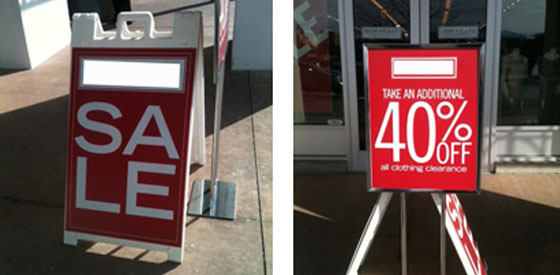
While I’m certainly not an expert shopper, I do know how to shop sales when I see a sale sign. For instance, at my two favorite clothing stores, I know that the new, full-priced merchandise is at the front of the store. The merchandise right behind the new stuff is usually 20% off. The merchandise behind that (about halfway between the front and back of the store) is on sale for 30% off. And at the back of the store, everything is 40% off. Merchandise rotates from the front to the back of the store every two weeks. So if I see a beautiful new suit hanging in the window, I can wait two weeks and get it at a 20% discount. This is not rocket science – it’s just a tiny bit of shopping savvy.
Sales Pricing Works
Customers usually pay attention to sales, but especially in a tough economy. And they base buying decisions on sales. Marketers know that customers love a good sale, and that they are more likely to buy based on the fact that the price is lower. Customers also feel an urgency to buy products that are on sale because they anticipate that the product will sell out at the reduced price and no longer be available. Some stores (like my two favorite clothing stores) use pricing strategies that build in sales prices in order to sell inventory.
Sales Signs Announce Bargains, but Sometimes Backfire
Signage is integral to a marketing strategy that includes placing products on sale. But can placing too many “Sale” signs throughout the store backfire? A study at the University of Chicago took a look at consumer behavior toward sales signs and it suggests that stores with too many “Sale” signs are losing out.
I never pay full price in one store where I shop. Partly because almost everything is on “sale” every day. So when I occasionally run into a full-priced item that I want, it seems over-priced. Standing in that store, I can gaze across the top of the clothing racks and see nothing but “Sale” signs. The few racks that don’t have signs are the racks that I avoid.
In addition to making sure that I don’t pay full-price, the proliferation of “Sale” signs makes it seem that the store never actually has sales, since the “sale” prices are typical, they’ve become “regular” prices.
Sale Signs Make Customers Buy Now . . . Sometimes
In the University of Chicago study, test subjects who saw a store where 25% of the products were labeled with “Sale” signs reported that they felt urgency to buy the product. They reported that they felt unsure that the product would be available later, and that they didn’t think the product would be priced lower. However, when test subjects entered a store where 75% of the products had “Sale” signs, they reported that that they felt confident that the price would decrease and that the product would still be available to purchase later.
Special Event Sales
Businesses drive more traffic and increase profits by holding special sales such as anniversary sales, summer clearance sales and holiday sales. But those positive results decrease significantly if the store holds too many “special” sales. If customers become accustomed to periodic sales where merchandise is offered at a significantly reduced price, they tend to wait for the sale to make purchases, especially if there is a very small amount of time in-between sales.
On the other hand, store that offer sales infrequently find that those sales are a boon. Nordstrom’s has historically offered semi-annual sales for each department, at different times during the year. Since the store doesn’t bombard shoppers with “Sales” signs on every rack during the rest of the year, the semi-annual events bring in lots of customers.
Place Sales Signs Effectively
Instead of offering a sale price on 75% of your merchandise, put only 25% on sale and place signage on only those racks. You’ll increase the chance of selling full-priced merchandise and your customers won’t get in the habit of only buying stuff from you when it’s on sale.



































